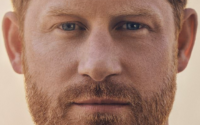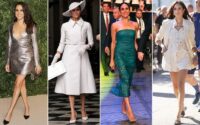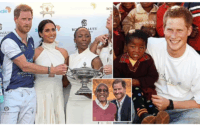New York Times article accuses Prince William of being ‘workshy’ – and claims Charles’ rift with Prince Harry ‘will reflect badly’ on the King’s legacy
The Prince Harry fallout will ‘reflect badly’ on King Charles III’s legacy and Prince William has been viewed as ‘workshy’, experts have told the New York Times in a takedown of the Royal Family.
The cancer-stricken monarch has ‘had the wind taken from his sails’ by the ongoing row with his son which he cannot resolve, according to royal historian Ed Owens.
He added that Harry’s estranged brother Prince William ‘has sometimes been seen as workshy’ but was now ‘gravitating toward bigger, more media-friendly events’.
And ex-BBC royal correspondent Peter Hunt told the newspaper that the King’s role is to ‘bring people together, and yet he can’t bring people together on his doorstep’.
The Left-wing New York Times published a news analysis piece in today’s paper under the headline: ‘Can King Charles Heal a Royal Family Crisis Before It’s Too Late?’
The subdeck reads: ‘Prince Harry’s desperate plea to reconcile with his father highlighted a rupture that could undermine the monarchy’s attempts to model unity.’
The article written by American journalist Mark Landler, the paper’s London bureau chief, claimed the King’s reign is ‘shaping up as both eventful and oddly unchanging in its core narrative: that of a beleaguered father managing a messy brood’.
It comes after a poll last week revealed Harry is the second most popular living member of the Royal Family among Americans – behind only his brother William.

Charles and his son Prince Harry together at the Natural History Museum in London in 2019

Charles walks Meghan down the aisle for her wedding to Harry at Windsor Castle in May 2018

Prince William (left) and Prince Harry (right) at Kensington Palace in London in July 2021
Harry said in a dramatic BBC television interview on May 2 that his ‘devastating’ loss in a case at the Court of Appeal, which rejected his bid to reinstate his round-the-clock police bodyguard in the UK, meant his family could never return to Britain.
He called for ‘reconciliation’ with his family and also claimed that Charles will not speak to him and he does not know ‘how much longer my father has’. The Duke described his court defeat as a ‘good old-fashioned establishment stitch-up’.
But his decision to speak out appears to have worsened the chances of an end to his estrangement, amid suggestions the King and William will fear more than ever that any conversation with California-based Harry would end up in the public domain.
The rest of the Royal Family meanwhile put on a united front in London last week to mark the 80th anniversary of VE Day in London on Monday as they watched a procession and flypast, followed by a concert on Thursday.
But Mr Owens told the New York Times: ‘There is an overhang in the way we see Charles’s reign. It hasn’t really gotten going, nor are we sure how long it will last.’
Mr Hunt added: ‘When history comes to be written about the king, this will reflect badly on him.
‘He represents an institution that is about family, unity and fostering forgiveness. His role is to bring people together, and yet he can’t bring people together on his doorstep.’
After Harry’s court defeat and subsequent interview, Buckingham Palace hit back with what the New York Times author described as an ‘unusually tart statement’.
The palace spokesman said: ‘All of these issues have been examined repeatedly and meticulously by the courts, with the same conclusion reached on each occasion,’
And Mr Hunt told the newspaper: ‘It’s a private issue but they are using the full weight of the institution to respond to him.’
The article also looked at how William had been thrust into a ‘more conspicuously public role’ – meeting President Donald Trump last year at the reopening of Notre Dame Cathedral in Paris, and attending the funeral of Pope Francis last month.
Mr Owens said: ‘William has sometimes been seen as workshy, but we see him gravitating toward bigger, more media-friendly events. He’s burnishing his reputation as a statesman.’
The author added that Charles has ’embraced his duties with a zeal that royal watchers say is either evidence of a robust recovery or the mark of a man who knows he has limited time’.
But Mr Owens said: ‘The man has had the wind taken from his sails.’

The Duke and Duchess of Sussex at the Time100 Summit in New York City on April 23, 2025

Kate, William, Harry and Meghan in Windsor in September 2022 after Queen Elizabeth II died
Last week, a YouGov study for The Times found some 56 per cent of US adults have a positive view of Harry while 21 per cent a negative opinion.
William meanwhile has a 63 per cent positivity rating in America and 10 per cent negative, which puts him in first place among living royals.
The most popular royal overall was William and Harry’s late mother Princess Diana , who died in 1997, with a 79 per cent positive rating and 4 per cent negative.
The late Queen Elizabeth II , who died in 2022, was in second place with a 73 per cent positive and 8 per cent negative ranking. William was in third overall and Harry fourth.
Harry, who moved to the US with his wife Meghan Markle in 2020 after stepping down as a senior royal, was more popular among Americans than his sister-in-law Kate.
The Princess of Wales has a 49 per cent positive rating and 6 per cent negative, while the King’s ratings were 48 per cent positive and 27 per cent negative.

(From left) Sophie, Edward, Vice Admiral Sir Tim Laurence, Princess Anne, the Duke of Kent, King Charles III, Queen Camilla, Prince William, Prince George, Kate, Prince Louis and Princess Charlotte on the Buckingham Palace balcony in London on May 5 for the VE Day 80 flypast
But William, Harry, Kate and Charles were all more popular than Meghan, the only US citizen on the list, whose ratings were 41 per cent positive and 25 per cent negative.
Even less popular than Meghan were Princess Anne (38 per cent positive; 6 per cent negative) and Prince Edward (38 per cent positive; 10 per cent negative).
Queen Camilla meanwhile was at joint-bottom in the table with a 26 per cent positive and 33 per cent negative rating.
This is the same rating on both counts as the disgraced Prince Andrew, who stepped back from royal duties in 2019. They were also the only two royals on the list with a net negative polling figure.


